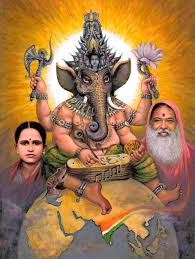Jaya Guru Datta
We discussed that on the auspicious day of Vaiśakha Krishna dasami (tenth day of the waning fortnight in the month of Vaiśakha), which was a Saturday, Anjana devi gave birth to a boy. The boy emerged from Anjana’s womb wearing a sacred thread, golden earrings and silken clothing. His jaws were very wide. Gods rained plentiful flowers from heaven upon the little one. Many auspicious omens were visible throughout the world. In great joy, all the Devatas sang in praise of Ānjaneya.
Thus, to Hanuman, who took birth from Anjana’s womb, Vali and Sugriva were maternal uncles. This was their relation. All those who are familiar with Ramayana are aware of these three characters and quite often wonder how they met and what was the reason for their close association.
The birth of Vali and Sugriva is explained differently in certain other texts. There is no harm in following any approach. Let us anyhow recount another version of their birth story.
Vānara Kunjara had a nephew Ruksharajasa who loved Anjana and always treated her as his own sister. Flying from atop one mountain to another was Ruksharajasa’s hobby. In the process of this gigantic leap he would cover many yojanas (one yogana is approx. 8 miles). Such was his energy and capacity.
One morning engrossed in jumping from one mountain to another he reached Mount Meru i.e. north pole. He found himself surrounded by snow on all sides. He was hungry but food was unavailable in this place. In that state, he lost track of the direction from where he had arrived. Unable to retrace his steps, he wandered in those snowy areas and survived for a few days. Upon studying the direction of the Sunrise and Sunset, he realized that he had arrived at the north pole.
In the ancient past, time as well as directions were ascertained purely by observing Sunrise and Sunset. Even now, those learned in this field quickly make these estimations using the palm of their hand. They will precisely calculate the hour and the minute based on the degree of the shadow. It is a mega science. Even to this date, in Greece, Brazil and Mexico we come across Sun-worshippers. People from the ancient civilizations in these lands had constructed temples for Sun-god. Why go that far? In Hampi, located in our Karnataka, this feature is visible. Based on the streak of sunlight that enters from a small hole in the ceiling, the learned members make precise calculation of the time.
Jaya Guru Datta
